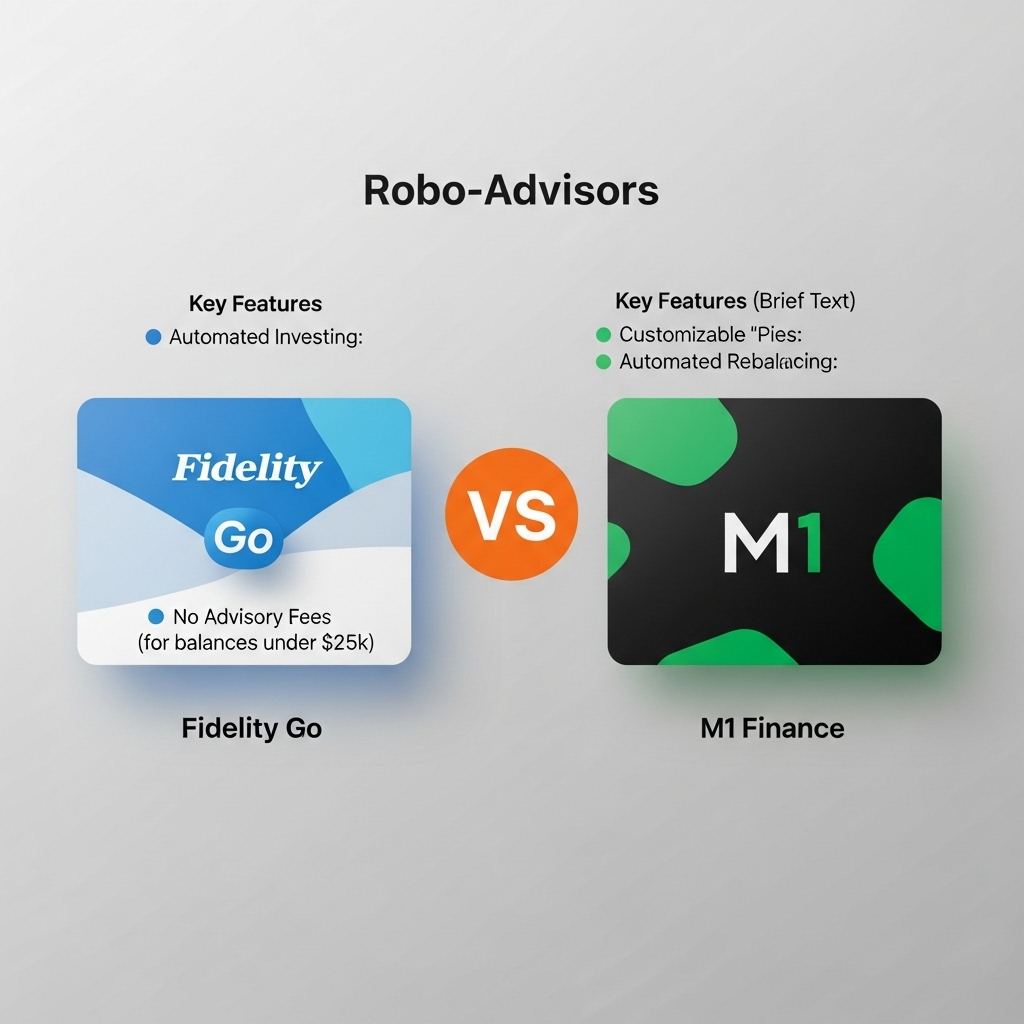Robo-advisors: Fidelity Go vs. M1 Finance
Quick Verdict
Fidelity Go is better for hands-off investors who may want human advisor access, while M1 Finance is better for those who want more control over their investments and SRI options.
- Fidelity Go offers access to human advisors for higher account balances, while M1 Finance does not offer human advisors.
- M1 Finance allows for more customization of portfolio allocation compared to Fidelity Go's pre-built portfolios.
- M1 Finance offers socially responsible investing options, while Fidelity Go does not.

Key features – Side-by-Side
| Attribute | Fidelity Go | M1 Finance |
|---|---|---|
| Minimum investment amount | $0 to open an account, $10 to start investing. | $100 for brokerage accounts, $500 for retirement accounts. |
| Annual advisory fee | No advisory fee for balances under $25,000; 0.35% per year for balances of $25,000 or more. | M1 Finance does not charge management fees or trading commissions. However, there's a $3 monthly platform fee for clients with less than $10,000 in total aggregated M1 accounts. |
| Investment portfolio options | Proprietary Fidelity Flex mutual funds; Investments in bonds, short-term, domestic, and foreign asset classes; 14 different pre-built portfolio allocations. | Stocks and ETFs. Limited over-the-counter (OTC) securities and cryptocurrencies are available. M1 does not offer mutual funds. |
| Tax-loss harvesting | Not offered. Fidelity Go prioritizes tax-advantaged investments like municipal bonds in taxable accounts. | M1 Finance does not offer automatic tax-loss harvesting. However, M1 offers a tax minimization strategy, selling tax lots in order from lowest to highest tax burden. |
| Availability of human advisors | Human financial planners are available for clients with account balances over $25,000; Clients with $25,000+ get access to unlimited 30-minute one-on-one phone calls. | M1 Finance does not offer advice from human advisors. |
| Socially responsible investing (SRI) options | Not offered. | M1 Finance offers socially responsible investing options. |
Overall Comparison
Fees: Fidelity Go competitive; Customization: M1 Finance wins; Human Advisors: Fidelity Go (>$25k); SRI: M1 Finance
Pros and Cons
Fidelity Go
Pros:
- Transparent about fees
- No trading fees, transaction fees, or rebalancing fees
- Accounts invest in zero expense ratio Fidelity mutual funds that do not charge management fees
- Customer service is generally viewed as polite, competent, and quick
- Offers 24/7 phone support and live chat during extended business hours
- Security features available on the larger Fidelity platform
- Option to enable two-factor authentication and biometric entry
- Platform is covered by the SIPC
Cons:
- Does not offer tax-loss harvesting
- Does not offer Socially Responsible Investing (SRI) options
M1 Finance
Pros:
- Customizable portfolios
- Socially responsible investing options
- Mobile app availability
- Financial planning tools and resources
- Dynamic rebalancing
Cons:
- No human advisors
- No automatic tax-loss harvesting
- $3 monthly fee for accounts under $10,000
- Inactivity fee of $50
- $100 fee per outgoing transfer
- $100 individual retirement account termination fee
User Experiences and Feedback
Fidelity Go
What Users Love
- Discloses its investment strategies and underlying holdings
- Allows you to select a different portfolio risk level
- Monitors the markets and automatically rebalances the portfolio to keep you on track
Common Complaints
- No major complaints reported.
Value Perception
- No value feedback reported.
M1 Finance
What Users Love
- No highlights reported.
Common Complaints
- No major complaints reported.
Value Perception
- No value feedback reported.